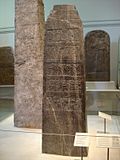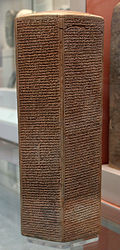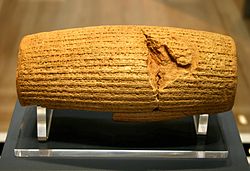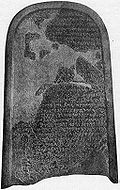Top Qs
Timeline
Chat
Perspective
List of inscriptions in biblical archaeology
From Wikipedia, the free encyclopedia
Remove ads
The following is a list of inscribed artifacts, items made or given shape by humans, that are significant to biblical archaeology.
Selected artifacts significant to biblical chronology
Summarize
Perspective
This table lists inscriptions which are of particular significance to the study of biblical chronology. References are from ANET[1] and COS[2] and link to editio princeps (EP), if known.
Egyptian
Other significant Egyptian artifacts
- Execration texts – earliest references to many Biblical locations
- Papyrus Brooklyn 35.1446 – A document that lists the names of 45 individuals, including a Canaanite woman named "Šp-ra." Scholars assume that this is a hieroglyphic transliteration of the Hebrew name "Shiphrah," which also appears in Exodus 1:15–21. However, while the name may be related, the document dates to c. 1833–1743 BCE (centuries before the biblical Shiphra would have lived).[4][5]
- Ipuwer Papyrus – poem describing Egypt as afflicted by natural disasters and in a state of chaos. The document is dated to around 1250 BC[6] but the content is thought to be earlier, dated back to the Middle Kingdom, though no earlier than the late Twelfth Dynasty.[7] Once thought to describe the biblical Exodus, it is now considered the world's earliest known treatise on political ethics, suggesting that a good king is one who controls unjust officials, thus carrying out the will of the gods.[8]
- Berlin pedestal relief – considered by many modern scholars to contain the earliest historic reference to ancient Israel.[9][10] Experts remain divided on this hypothesis.[11]
Cuneiform
Other significant cuneiform artifacts
- Creation myths and flood myths – recorded on the Epic of Gilgamesh, the Atra-Hasis tablets, the Enûma Eliš, the Eridu Genesis and the Barton Cylinder
- Law tablets – ancient Near East legal tablets: Code of Hammurabi, Laws of Eshnunna, the Code of Ur-Nammu, king of Ur (c. 2050 BC), the Laws of Eshnunna (c. 1930 BC) and the Code of Lipit-Ishtar of Isin (c. 1870 BC).[20] Later codes than Hammurabi's include the Code of the Nesilim.[21] Hittite laws, the Assyrian laws, and Mosaic Law / Ten Commandments. (see cuneiform law).
- Tell al-Rimah stela (c. 780 BC) – tells of the exploits of Adad-nirari III, mentioning "Joash King of Samaria"[22]
- Annals of Tiglath-Pileser III (740–730 BC):
- Layard 45b+ III R 9,1 possibly refers to [KUR sa-me-ri-i-na-a-a] as ["land of Samaria"][23]
- The Iran Stela refers to KUR sa-m[e]-ri-i-na-a-[a] "land of Samaria"[23]
- Layard 50a + 50b + 67a refers to URU sa-me-ri-na-a-a "city of Samaria"[23]
- Layard 66 refers to URU Sa-me-ri-na "city of Samaria"[23]
- III R 9.3 50, refers to "Menahem the Samarian"[22][24]
- Nimrud Tablet III R 10.2 28–29, refers to the overthrown of Pekah by Hoshea.[22][24]
- one fragment refers to "Azriau" and another it has been joined to refers to "Yaudi". Some scholars have interpreted this as Ahaziah / Uzziah, although this is disputed and has not gained scholarly consensus.[25][26][27][28]
- III R 10,2 refers to KUR E Hu-um-ri-a "land of Bit-Humri"[23]
- ND 4301 + 4305 refers to KUR E Hu-um-ri-a "land of Bit-Humri"[23]
- Babylonian Chronicle ABC1 (725 BC) – Shalmaneser V refers to URU Sa-ma/ba-ra-'-in "city of Samar(i)a"[23]
- Annals of Sargon II (720 BC):
- Victory stele of Esarhaddon – a dolerite[29] stele commemorating the return of Esarhaddon after his army's second battle and victory over Pharaoh Taharqa in northern ancient Egypt in 671 BC, discovered in 1888 in Zincirli Höyük (Sam'al, or Yadiya) by Felix von Luschan and Robert Koldewey. It is now in the Pergamon Museum in Berlin.
- Esarhaddon's Succession Treaty (written around 675 BCE) – Some scholars think that this treaty served as a literary model for the curses in Deuteronomy 28:15–64, as well as content in Deuteronomy 13, due to strong textual similarities.[30][31]
- Nebo-Sarsekim Tablet (circa 595 BC) – a clay cuneiform inscription referring to an official at the court of Nebuchadrezzar II, king of Babylon, possibly the same official named in the Biblical Jeremiah.
- Jehoiachin's Rations Tablets (6th century BC) – Describe the rations set aside for a royal captive identified with Jehoiachin, king of Judah (Cf. 2 Kings 24:12,15–16; 25:27–30; 2 Chronicles 36:9–10; Jeremiah 22:24–26; 29:2; 52:31–34; Ezekiel 17:12).[32]
Canaanite, Aramaic and Hebrew
Other significant Canaanite, Aramaic and Hebrew artifacts

- Early Paleo-Hebrew writing – contenders for the earliest Hebrew inscriptions include the Gezer calendar, Biblical period ostraca at Elah and Izbet Sartah,[40] and the Zayit Stone
- Yeho'ezer ben Hosh'ayahu seal – 2,700 year old seal discovered in 2024 in Jerusalem. Neo-Assyrian-style amulet thought to be from First Temple Period, likely Judahite senior administrator[41]
- Pim weight – evidence of the use of an ancient source for the Book of Samuel due to the use of an archaic term.
- Khirbet Qeiyafa ostracon – 10th century BC inscription – both the language it is written in and the translation are disputed. Was discovered in excavations near Israel's Elah valley.[42]
- Tell es-Safi inscription (10th to mid 9th centuries BC) – Potsherd inscribed with the two names "alwt" and "wlt", etymologically related to the name Goliath and demonstrate that the name fits with the context of late-tenth/early-ninth-century BC Philistine culture. Found at Tell es-Safi, the traditional identification of Gath.
- Ophel pithos is a 3,000-year-old inscribed fragment of a ceramic jar found near Jerusalem's Temple Mount by archeologist Eilat Mazar. It is the earliest alphabetical inscription found in Jerusalem written in what was probably Proto-Canaanite script.[43] Some scholars believe it to be an inscription of the type of wine that was held in a jar.[44]
- Amman Citadel Inscription – 9th century BC inscription in the Ammonite language, one of the few surviving written records of Ammon.
- Melqart stele – (9th–8th century BC) William F. Albright identifies Bar-hadad with Ben-hadad I, who was a contemporary of the biblical Asa and Baasha.
- Ostraca House – (probably about 850 BC, at least prior to 750 BC) 64 legible ostraca found in the treasury of Ahab – written in early Hebrew.
- Deir Alla Inscription (c. 840–760 BC)[45] 9th or 8th century BC inscription about a prophet named Balaam (cf. the Book of Numbers).[46]
- Kuntillet Ajrud inscriptions – (9th–8th century BC) Jar and plaster inscriptions, stone incisions, and art with "Yahweh and his Asherah".
- Sefire steles (8th century BC) – described as "the best extrabiblical source for West Semitic traditions of covenantal blessings and curses".[47]
- Stele of Zakkur (8th century BC) – Mentions Hazael king of Aram.
- Shebna Inscription (8th–7th century BC?) – found over the lintel or doorway of a tomb, has been ascribed to Hezekiah's comptroller Shebna.
- Bullae (c. 715–687 BC or 716–687 BC)[48] (clay roundels impressed with a personal seal identifying the owner of an object, the author of a document, etc.) are, like ostraka, relatively common, both in digs and on the antiquities market. The identification of individuals named in bullae with equivalent names from the Bible is difficult, but identifications have been made with king Hezekiah[49] and his servants (avadim in Hebrew, [עבדים – slaves])
- Bulla of Gemariah son of Shaphan (r. 609–598 BC) – possible link to a figure during the reign of Jehoiakim (Jeremiah 36:10). Archaeologist Yair Shoham notes: "It should be borne in mind, however, that the names found on the bullae were popular in ancient times and it is equally possible that there is no connection between the names found on the bullae and the person mentioned in the Bible."[50]
- Seal of Jehucal (7th century BC) – Jehucal or Jucal is mentioned in chapters 37 and 38 of the Book of Jeremiah where King Zedekiah sends Jehucal son of Shelemiah and the priest Zephaniah son of Maaseiah to the prophet Jeremiah saying "Please pray for us to the Lord our God" (Jeremiah 37:3). His seal and also one of Gedaliah, son of Pashhur (also mentioned in Jeremiah 38:1 together with Jehucal) were found within a few yards from each other during excavations in the city of David, Jerusalem, in 2005 and 2008, respectively, by Eilat Mazar.[51]
- Bullae of Eliakhim – In 2019, archaeologist Yosef Garfinkel claimed to have discovered a reference to Eliakhim, son of Hilkiah, in two bullae unearthed at Tel Lachish. He described the seal legends as reading "Eliakim, (son of) Yehozarah".[52] The stratified bulla, publicized with three others, is sibling to an earlier find from the market.

- Seals
- Seal of Jaazaniah – Features skillfully ground onyx into appearance of eye with black pupil. Cock image proof of chickens in Palestine before Hellenistic times.[53]
- Seal of Hezekiah – 8th. c BCE[54]
- King Ahaz's Seal (732 to 716 BC) – Ahaz was a king of Judah but "did not do what was right in the sight of the Lord his God, as his ancestor David had done" (2 Kings 16:2; 2 Chronicles 28:1). He worshiped idols and followed pagan practices. "He even made his son pass through fire, according to the abominable practices of the nations" (2 Kings 16:3). Ahaz was the son and successor of Jotham.
- Seal of פלטה (Paltah) – one known of at least seven women's names on inscribed Hebrew seals with a pedigree. Provenanced seals constitute 7% of what's on record.[55]
- Khirbet Beit Lei graffiti contains oldest known Hebrew writing of the word "Jerusalem", dated to 7th century BC: "I am YHWH thy Lord. I will accept the cities of Judah and I will redeem Jerusalem. ... Absolve us oh merciful God. Absolve us oh YHWH"[56]
- Yavne-Yam ostracon is an inscribed pottery fragment dated to 7th century BC and written in ancient Hebrew language. It contains early attestation of the word Shabbat.[57][58]

- Ketef Hinnom scrolls – Probably the oldest surviving texts currently known from the Hebrew Bible – priestly blessing dated to 600 BC.[59] Text from the Book of Numbers in the Old Testament. Described as "one of most significant discoveries ever made" for biblical studies.[60][61]
- Lachish letters – letters written in carbon ink by Hoshaiah (cf. Nehemiah 12:32, Jeremiah 42:1, 43:2), a military officer stationed near Jerusalem, to Joash the commanding officer at Lachish during the last years of Jeremiah during Zedekiah's reign (c.588 BC) (see Jeremiah 34:7). Lachish fell soon after, two years before the fall of Jerusalem.[62]
- Lachish ewer – a pot with sacred trees and more, often mentioned in academic discussion
- Arad ostraca – the "House of Yahweh" ostracon is an ancient pottery fragment discovered at Tel Arad probably referring to the Temple at Jerusalem.[63]
- Elephantine papyri – ancient Jewish papyri dating to the 5th century BC, name three persons mentioned in Nehemiah: Darius II, Sanballat the Horonite and Johanan the high priest.
- Hasmonean coinage (164–35 BC)
Greek and Latin
Other significant Greek and Latin artifacts
- Pilate Stone (c. 36 AD) – carved inscription attributed to Pontius Pilate, a prefect of the Roman-controlled province of Judaea from 26 to 36 AD.
- Delphi Inscription (c. 52 AD) – The reference to proconsul Gallio in the inscription provides an important marker for developing a chronology of the life of Apostle Paul by relating it to the trial of Paul in Achaea mentioned in the Acts of the Apostles (18:12–17).
- Erastus Inscription (Roman period) – an inscription found in 1929 near a paved area northeast of the theater of Corinth, dated to the mid-first century and reads "Erastus in return for his aedileship paved it at his own expense."[65] Some New Testament scholars have identified this aedile Erastus with the Erastus mentioned in the Epistle to the Romans but this is disputed by others.[66][67]
- Judaea Capta coinage (after 70 AD) – a series of commemorative coins originally issued by the Roman Emperor Vespasian to celebrate the capture of Judaea and the destruction of the Jewish Second Temple by his son Titus in 70 AD during the First Jewish Revolt.
- Nazareth Inscription bears an edict of Caesar prohibiting grave robbing.
Remove ads
Controversial (forgery, claimed forgery, or identification disputed)
- Uzziah Tablet (8th century BC or 30–70 AD?) – controversial tablet discovered in 1931 by Professor E. L. Sukenik of the Hebrew University of Jerusalem in a Russian convent.
- Jehoash Inscription – controversial black stone tablet in Phoenician regarding King Jehoash's repair work. Suspected to be a forgery.
- Ivory pomegranate – a thumb-sized semitic ornamental artifact bears an inscription: "Holy to the Priest of the House of God [blank, but reconstructed YHWH]", thought to have adorned the High Priest's sceptre within the Holy of Holies. Suspected to be a forged inscription on an older item rather than a newer one, but unresolved.
- James Ossuary – a 1st-century limestone box that was used for containing the bones of the dead, bearing an Aramaic inscription in the Hebrew alphabet, "James, son of Joseph, brother of Jesus", cut into one side of the box. Suspected to be a forgery.
- Caiaphas ossuary – a highly decorated ossuary twice inscribed "Joseph, son of Caiaphas" which held the bones of a 60-year-old male, discovered in a burial cave in south Jerusalem in November 1990.
- Miriam ossuary – a decorated ossuary inscribed "Miriam, daughter of Yeshua, son of Caiaphas", found in a tomb in the Valley of Elah in 2011.
- Titulus Crucis – a piece of wood claimed to be a relic of the True Cross, which Christian tradition holds to be a part of the cross's titulus (inscription), now kept in the church of Santa Croce in Gerusalemme in Rome. Radiocarbon dating tests on the artifact have shown that it dates between 980 and 1146 AD.
- Shapira Scroll, leather strips containing a somewhat different text of the Ten Commandments, belonging to Moses Wilhelm Shapira, a Jerusalem antiquities dealer. Widely discredited following its 1883 release, resulting in Shapira's suicide.[68][69] Has been reassessed following the 1946 discovery of the Dead Sea Scrolls.[68][69]
- Seal of Manasseh – Stone seal of Manasseh, King of Judah c.687–642 BC. Reportedly offered to a private collector for one million dollars.[70]
- Seals of Baruch – controversial bullae allegedly belonging to Baruch, son of Neriah. Suspected to be forgeries.[71]
- Seal of Ahaz – Some scholars stipulate that this is in fact a forgery.[72]
- Shema Seal – bullae that mentions the name of Jeroboam II and is written in Paleo Hebrew.[73]
Remove ads
Significant museums
Concordance of external lists
- ANET: Ancient Near Eastern Texts Relating to the Old Testament. Third Edition with Supplement. Ed. James B. Pritchard. Princeton: Princeton Univ. Press, 1969
- COS: The Context of Scripture. 3 volumes. Eds. William W. Hallo and K. Lawson Younger. Leiden: Brill, 1997–2002
Remove ads
Other external lists
- RANE: Readings from the Ancient Near East: Primary Sources for Old Testament Study. Baker Academic. September 2002. ISBN 978-0801022920.
- Mercer, S.A.B. (1913). Extra-Biblical Sources for Hebrew and Jewish History. Longmans & Company. ISBN 978-0-7905-1132-0.
{{cite book}}: ISBN / Date incompatibility (help)
See also
- Archaeology of Israel
- Assyro-Babylonian religion
- The Bible and history
- Biblical archaeology (excavations and artifacts)
- Canaanite and Aramaic inscriptions
- Levantine archaeology
- Library of Ashurbanipal
- List of biblical figures identified in extra-biblical sources
- List of Egyptian papyri by date
- List of proposed Assyrian references to Kingdom of Israel (Samaria)
- Model of Jerusalem in the Late 2nd Temple Period
- Near Eastern archaeology
- Nag Hammadi library – early Christian gnostic papyri.
- Non-canonical books referenced in the Bible
- Oxyrhynchus Papyri – collection of Old and New Testament papyri, Apocryphal works and works of Philo
Remove ads
References
Wikiwand - on
Seamless Wikipedia browsing. On steroids.
Remove ads



























